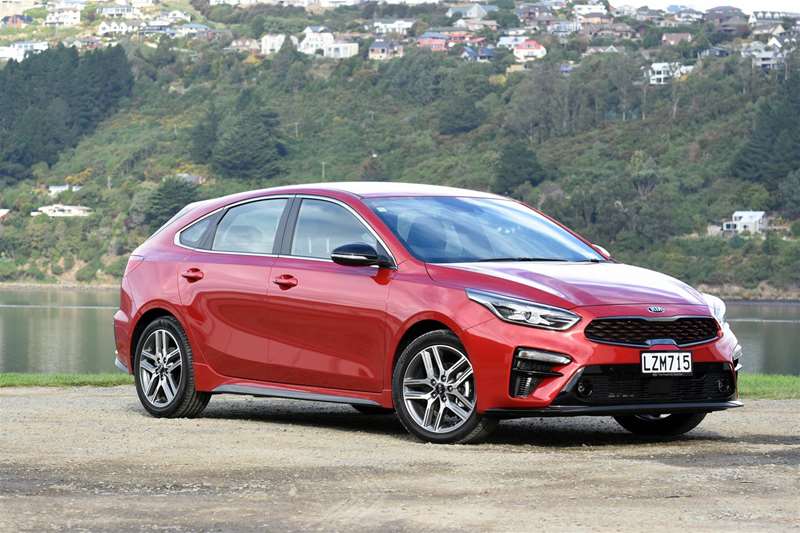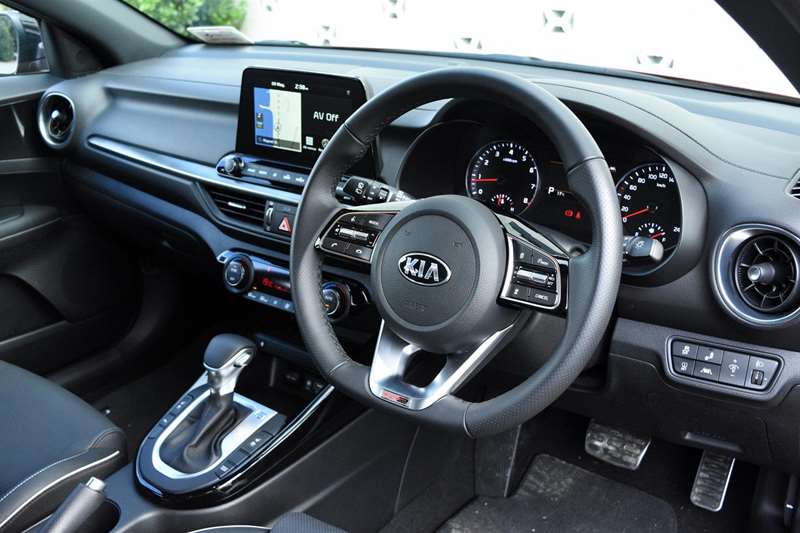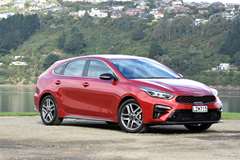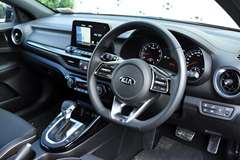Kia is looking to the new, fourth-generation Cerato to follow in the footsteps of the Sportage, New Zealand’s second-best selling passenger vehicle. David Thomson got behind the wheel of the Cerato GT-Line.
While much of Kia’s attention this year will be on the stellar sales chart performance of is Sportage SUV — New Zealand’s second-best selling passenger vehicle year to date — the Korean company will also be looking for a positive showing by the all-new Cerato.
Launched here in February, this is the fourth-generation Cerato.
Both four-door sedan and five-door hatch back models are on offer at entry level LX and intermediate EX specification, priced at $31,900 and $35,900 respectively in either body configuration. Then comes the hatchback-only GT-Line and pure GT variants, listing at $39,990 and $41,990.
Featuring an exciting new 150kW/265Nm 1.6L turbo engine, six-speed sequential automatic transmission, the GT holds obvious appeal for the more sporty-minded driver. Meantime, the LX, EX and GT-Line take a 112kW/192Nm non-turbo 2L motor that carries over from the previous Cerato, with this engine mated to a seven-speed dual-clutch automatic.
Safety gets a high billing across the new range, with all variants featuring autonomous emergency braking, adaptive radar cruise control, lane keeping assistance, blind spot monitoring, driver attention alert, tyre pressure monitoring, and both parking sensors and a rear-view camera. Other features that are standard across the range include keyless entry and starting, an eight-inch centre touchscreen, heated side mirrors, Android Auto and Apple Car Play smartphone integration.
The GT-Line was the Cerato version Kia supplied for this Drivesouth appraisal.
Like EX, it takes 17-inch alloys and 225/45 tyres, LED running lights, composite leather trim, heated front seats, and dual zone climate control air-conditioning over-and-above the base model specification. The GT-Line also picks up LED head and tail lights, a power-operated driver’s seat, a sports steering wheel, satellite navigation, ventilated front seats, wireless phone charging, and a colour display for the central instrument cluster.
With styling leadership for this vehicle coming out of Kia’s American design centre in Southern California, the new Cerato looks quite different from its predecessor. An extended roofline (almost wagon-esque at the rear) and an increased rear overhang are the most obvious changes.
There are echoes of the company’s sporty Stinger in the nose (which is anchored by the latest iteration of the Kia’s tiger-nose grille), its relatively long bonnet, and in the prominent crease line that runs along the car’s flanks from the top of each headlight to the top of each tail light.
Working with the same 2700mm wheelbase as the previous Cerato, the design team have used the new roofline and extended rear to boost luggage space, which rises by 10% to a class-leading 428L. Split 60:40, the rear seat backs tip forward when required to extend that space further; just the trick on test when delivering a medium-sized bookcase to my son’s student flat.
When raised, the rear seats provide decent leg room and adequate headroom for adults, with a fold-down centre armrest incorporating twin cup holders and separate vents with airflow control. The back seat can feel a little closed-in though, due in part to the Cerato’s quite high waistline, and also to the choice of a dark finish for the door pillar and roof lining trims.
Front seat occupants are accommodated in comfortable and supportive GT-Line embossed sports seats. They are separated in what is a pleasantly roomy space by a deep centre storage bin with a USB charging port. There is also a nicely provisioned storage area forward of the gearshift, comprising a cubby with two USB ports (one for charging) and AUX and 12-volt sockets, and topped by a shelf that doubles as a wireless charging pad.
The dashboard is clean-lined, with a burnished metal highlight bar running across the passenger’s side and under the prominent 8-inch centre display touchscreen. The centre screen is home base for the satellite navigation as well as the usual phone, radio, audio and connectivity functions. While there is nothing fancy about any element of the interface, it is clear and easy to use.
Minimisation of clutter is also evident in the main instrument panel, where traditional analogue dials for the tachometer and speedometer flank a clear centre digital display screen.
The GT-Line offers four different drive modes, of which three — eco, smart and comfort — are selected via a button beside the gearshift. The fourth — sport — is engaged by slotting the gearshift right into the transmission’s tiptronic shift gate.
Gear changes are smooth in any of the modes, with smart or comfort mode the obvious choices for everyday urban driving. The test car proved a largely undemanding city vehicle, helped considerably by its light steering and compliant slow to medium-speed ride. It is a similarly smooth-riding machine during main highway driving, with wind and road noise nicely contained.
Kia makes much of its major models receiving special suspension tuning for our part of the world through its so-called ANZAC programme.
This being so, I must confess to being disappointed by the feel of the GT-Line when pressed down both winding stretches of highway and more demanding back roads. Yes, ride quality is very good and handling is composed enough.
But in this guise, the new Cerato doesn’t have enough steering feel or agility to captivate the enthusiast, and there’s some understeer and a tendency for offside front tyre loading when pressing on.
Similarly, the engine, while completely acceptable in most situations, doesn’t offer a massive amount in a sporting sense. It must be worked quite hard to maintain pace up the steeper highway hills one finds in our part of the world, with the transmission’s sport mode the best option for this purpose.
In making these observations I am mindful that Kia does have the pure GT in the mix as the performance choice within the new Cerato range. Possessed of uprated brakes and multi-link rather than torsion link rear suspension, as well as a third more power and close to 40% more torque than the GT-Line, it promises much. That said, the GT-Line and its 2.0-litre siblings are probably completely adequate for most motorists needs.
Photos: David Thomson












